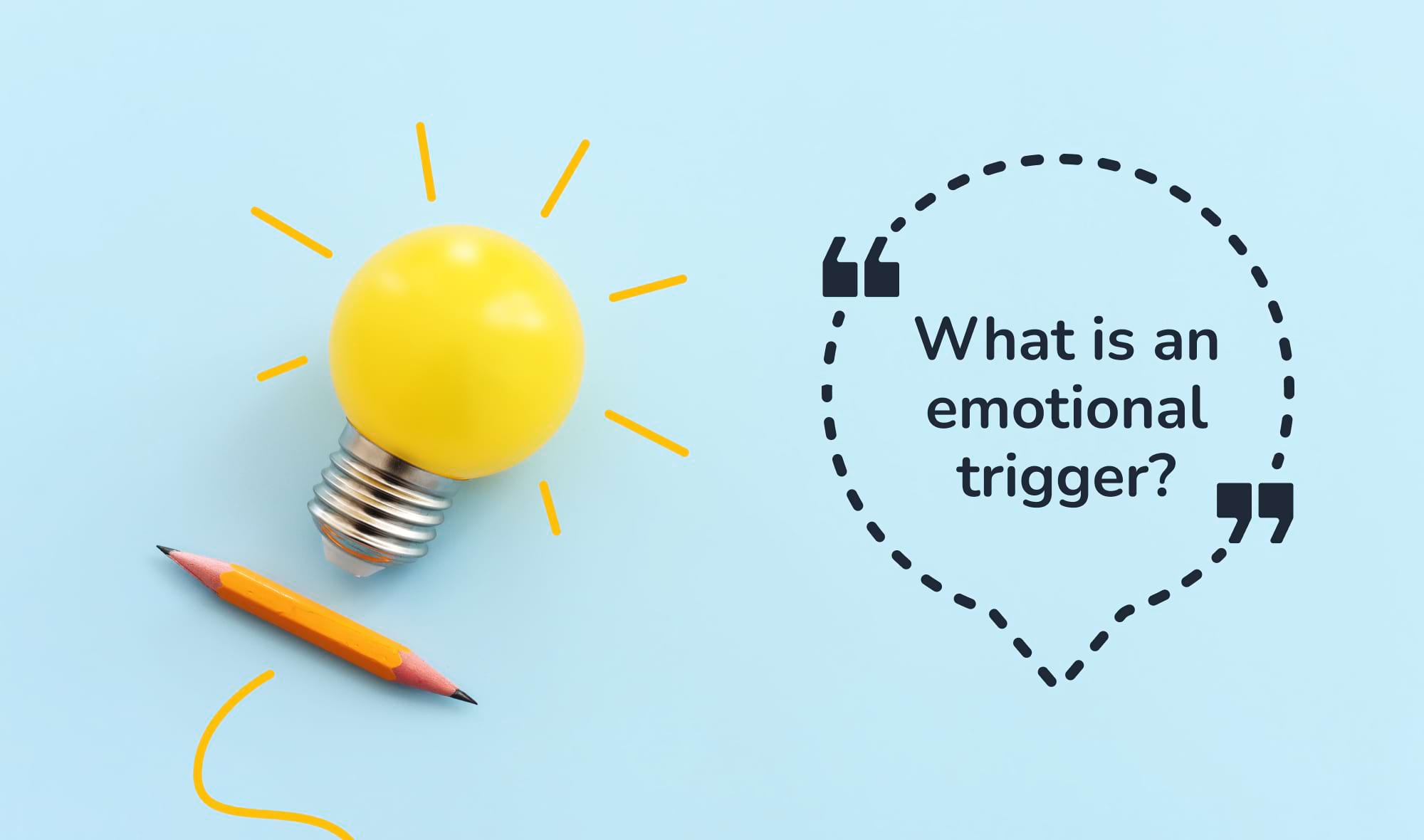Identifying emotional triggers: how to respond in a healthy way
By Remy Meraz • May 2, 2023

Emotions are an integral part of human existence, and they play a crucial role in shaping our lives. However, emotions can also be intense and overwhelming, especially when they are triggered by certain events or situations in our daily lives. When we react to these triggers without thought, we may find ourselves in unpleasant situations, causing harm to ourselves and those around us.
In this blog post, we will explore the importance of learning to navigate emotional triggers and provide practical tips on how to shift from reacting to responding to them in your daily life. Read on to gain a better understanding of how to manage your emotions, improve your relationships, and lead a more fulfilling life.
Join our Newsletter
Transform your career with our personal growth insights. Get one valuable tip right in your inbox every Saturday morning.
What is an emotional trigger?

Emotional triggers are events or situations that activate an emotional response and cause us to react in a certain way. These triggers can be positive or negative and are often associated with a particular person, past traumas, or certain beliefs and values.
There are many common types of emotional triggers, including:
Relationship triggers:
Relationship triggers are specific situations or behaviors that trigger negative emotional reactions in our interactions with others. These triggers can be related to our past experiences or beliefs and can manifest in a variety of ways, such as feeling criticized or rejected.
Common relationship triggers include rejection, betrayal, abandonment, and feeling unimportant or insignificant. These triggers can be subtle or overt and can occur in various settings, such as at work, with friends, or in romantic relationships.
Environment triggers:
Environment triggers include specific smells, sounds, or visual cues that are associated with negative circumstances or a traumatic event. For example, an individual who was involved in a car accident may experience anxiety or fear when hearing the sound of screeching tires or seeing a car crash on television.
Physical signs associated with environmental triggers can vary widely, depending on the individual and the nature of the trigger. Some common physical symptoms of environmental triggers include heart pounding, muscle tension or pain, and feeling short of breath.
Internal triggers:
Internal triggers are common in those with mental health conditions, such as anxiety, depression, or post-traumatic stress disorder (PTSD). These conditions can cause individuals to experience intense negative emotions in the midst of situations or thoughts that others may perceive as minor or insignificant.
For instance, an individual with anxiety may experience the intense emotional reaction of worry or fear in response to specific thoughts or situations, such as being in a crowded place or thinking about past trauma. This can cause them to feel overwhelmed or stressed and may lead to physical symptoms such as sweating, rapid heartbeat, or difficulty breathing.
Other common internal triggers include negative self-talk, feelings of shame or guilt, or memories of past traumas or negative experiences. These triggers can cause individuals to experience a strong emotional response, such as anger, sadness, or anxiety.
Trauma triggers:
Trauma triggers are specific situations or factors related to past traumatic experiences that can trigger negative emotional responses, such as feeling triggered by a particular sound or situation. Trauma triggers are different from environmental triggers in that they are specifically related to past traumatic experiences and can often cause a more severe emotional response.
For instance, a person who has been sexually assaulted might experience intense emotional reactions, such as anxiety or panic when they encounter a particular smell or sound that was present during the assault. The intensity of the response can be overwhelming, and it may cause the person to experience flashbacks.
Emotional triggers can impact our daily lives in many ways. When we are triggered, our emotions can become intense, and we may react impulsively, often without considering the consequences. This can lead to conflicts, damaged relationships, and increased stress levels.
Moreover, emotional triggers can also lead to unhealthy coping mechanisms, such as overeating, substance abuse, or avoidance behaviors. Therefore, it is crucial to learn how to identify emotional triggers and work through unpleasant emotions in a healthy way to lead a more fulfilling and satisfying life.
Reacting vs. responding to emotional triggers

Reacting and responding are two different ways in which we can approach emotional triggers. Reactive behavior involves an automatic and impulsive response to a trigger, while responsive behavior involves a more thoughtful and intentional response.
Reacting to emotional triggers often involves a knee-jerk response that is based on instinct or past experiences. This type of behavior can be impulsive and can lead to conflict and negative outcomes. For example, if someone makes a critical comment, a reactive response might involve becoming upset, lashing out in anger, or shutting down emotionally, without considering the impact of these actions.
On the other hand, responding to emotional triggers involves taking a step back and considering the situation before taking action. This type of behavior is more thoughtful and intentional and often involves an evaluation of the trigger and how best to respond to it. Responsive behavior might involve actively listening to the critical comment, understanding the speaker's perspective, and responding in a respectful and constructive manner.
Understanding and identifying personal emotional triggers

Understanding and identifying personal emotional triggers is essential for managing our emotions and developing healthier coping mechanisms. Personal triggers are unique to each individual and are often based on past experiences, beliefs, and values. By understanding our personal triggers, we can learn how to manage them effectively and prevent them from negatively impacting our lives.
Identifying personal emotional triggers can be challenging, but some common examples include:
- Criticism: Feeling criticized or judged can trigger feelings of anger or defensiveness.
- Change: Significant life changes such as moving, starting a new job, or ending a relationship can trigger panic and stress.
- Abandonment: People who have experienced abandonment in the past may feel triggered by situations that involve separation or loss.
- Failure: Fear of failure can be a trigger for feelings of inadequacy or anxiety.
- Rejection: Rejection, whether real or perceived, can be an emotional trigger for feelings of sadness, anger, or self-doubt.
Join our Newsletter
Transform your career with our personal growth insights. Get one valuable tip right in your inbox every Saturday morning.
Understanding personal triggers is crucial because it allows us to be more self-aware and take control of our emotional responses. Once we identify our triggers, we can develop strategies to manage them effectively. For example, if criticism is a personal trigger, we might practice self-compassion and challenge negative self-talk. If change is a trigger, we might develop a support system or practice mindfulness techniques to reduce stress.
Check out Mindful leadership coaching: how to become a mindful leader for more on this topic.
Strategies for navigating emotional triggers

Addressing psychological triggers and processing unpleasant feelings can be challenging because our emotions are complex and multifaceted. We are often influenced by our past experiences, beliefs, and values, which can shape how we respond to triggers. Moreover, our emotional responses can be intense and overwhelming, making it difficult to navigate triggers and process unpleasant feelings. For more on this, check out "Erikson's Stages of Psychosocial Development Explained".
However, there are several effective strategies that can help to address psychological triggers and process negative emotions. Some examples include:
Mindfulness and awareness:
Mindfulness and awareness involve paying attention to the present moment without judgment. When dealing with emotional triggers, this means acknowledging and observing our thoughts and feelings as they arise. This can help to create a sense of detachment from our emotions and reduce their impact on our daily lives.
Emotion regulation techniques:
Emotion regulation techniques are strategies that help to manage and regulate our emotions. These techniques can be useful for reducing the intensity of our emotional responses to triggers. Examples of emotion regulation techniques include deep breathing exercises, progressive muscle relaxation, and mindfulness meditation.
Cognitive restructuring:
Cognitive restructuring involves identifying and challenging negative thought patterns that contribute to emotional triggers. This strategy helps to replace negative thoughts with more positive and realistic ones. Cognitive restructuring can be a powerful tool for reducing the impact of emotional triggers on our daily lives.
Setting boundaries:
Setting boundaries involves establishing limits on what we will and will not tolerate in our lives. This strategy can be useful for managing emotional triggers that arise from our relationships with others. By setting clear boundaries, we can reduce the impact of triggers on our relationships and promote emotional wellness.
This can be particularly valuable with dealing with narcissists. For more on the topic, check out "Unveiling the Dark Art of Gaslighting: Real-World Gaslight Examples and Experiences".
Self-care practices:
Self-care practices involve taking care of ourselves physically, emotionally, and mentally. This strategy can be helpful for managing emotional triggers by reducing stress and promoting overall well-being. Examples of self-care practices include exercise, getting enough sleep, and engaging in activities that bring us joy. Incorporating healthy habits is key. Learn more about 20 daily habits to track for improved mental wellness.
Putting it all together: applying strategies in daily life

To apply these strategies in real-life situations, let's consider three examples:
Example 1: Receiving negative feedback at work
In this situation, practicing mindfulness and awareness can help to ground oneself in the present moment and reduce the impact of the psychological trigger. Using emotion regulation techniques such as deep breathing exercises can help to manage intense emotional responses. Cognitive restructuring can help to challenge negative thoughts and beliefs and replace them with more positive ones. Setting boundaries with supervisors can help to establish realistic goals and expectations, and self-care practices can promote overall well-being.
Example 2: Facing anxiety and stress during public speaking
In this situation, mindfulness and awareness can help to acknowledge and accept feelings of anxiety without judgment. Emotion regulation techniques such as deep breathing exercises and mindfulness meditation can help to manage anxiety and reduce stress levels. Cognitive restructuring can help to challenge negative thoughts and beliefs and replace them with positive affirmations. Setting boundaries with others by requesting support and guidance can also be helpful, as well as practicing self-care by engaging in relaxation techniques.
Example 3: Dealing with a difficult family member
In this situation, practicing mindfulness and awareness can help to acknowledge and observe feelings of anger and frustration without reacting impulsively. Emotion regulation techniques such as deep breathing exercises and progressive muscle relaxation can help to manage intense emotional responses. Cognitive restructuring can help to challenge negative thoughts and beliefs, identify emotional triggers and establish healthy boundaries. Setting boundaries with difficult family members by communicating needs and expectations can also be helpful, as well as practicing self-care by engaging in activities that bring joy and relaxation.
Recap: mastering mental health with responsive behavior

Learning to navigate emotional triggers is an essential skill for improving our emotional well-being and enhancing the quality of our lives. By recognizing our personal triggers and implementing responsive behavior, we can take control of our emotional responses and reduce the impact of triggers on our daily lives.
It's important to remember that developing responsive behavior takes time and practice. It's okay to seek support from a therapist or life coach if needed and to prioritize self-care and self-compassion in our daily routines. By taking proactive steps to address emotional triggers and promote emotional wellness, we can improve our ability to handle challenging situations and enhance our overall quality of life.
Let's make the choice to respond instead of react, and take control of our emotional well-being. With practice and commitment, we can develop the skills and strategies necessary to navigate emotional triggers and improve our lives.
Learn more about Zella Life and why Google decided to fund it: Zella Life selected for Google for Startups Latino Founders Fund.
Join our Newsletter
Transform your career with our personal growth insights. Get one valuable tip right in your inbox every Saturday morning.
Read more about: Life Coaching
About Remy Meraz
Remy Meraz, co-founder, and CEO of Zella Life, is a visionary leader who leveraged corporate glass ceiling challenges as a woman of color to drive systemic change.
While leading and cultivating high-performance teams from VC-backed startups to Fortune 500, she consistently faced obstacles such as inadequate mentorship, lack of psychological safety, and non-personalized training. Taking matters into her own hands, she turned to executive coaching and NLP training. This life-changing growth experience led to breaking leadership barriers and a passion for cognitive psychology.
Motivated by her experiences, she co-founded Zella Life, an innovative AI-driven coaching platform bridging the talent development gap by enhancing soft skills and emotional intelligence (EQ) in the workplace.
Her vision with Zella Life is to transform professional development into an inclusive and impactful journey, focused on the distinct needs of both individuals and organizations. She aims to promote advancement and culture change by ensuring every professional's growth is acknowledged and supported.
Today, Remy is recognized as an influential innovator, trainer, mentor, and business leader. Under her leadership, Zella Life has delivered significant measurable outcomes for numerous well-known brands. This track record of positive outcomes garnered attention and funding from Google for Startups and Pledge LA, establishing Zella Life as a pivotal force in the learning and development arena tackling and resolving fundamental talent development issues for organizations of all sizes.